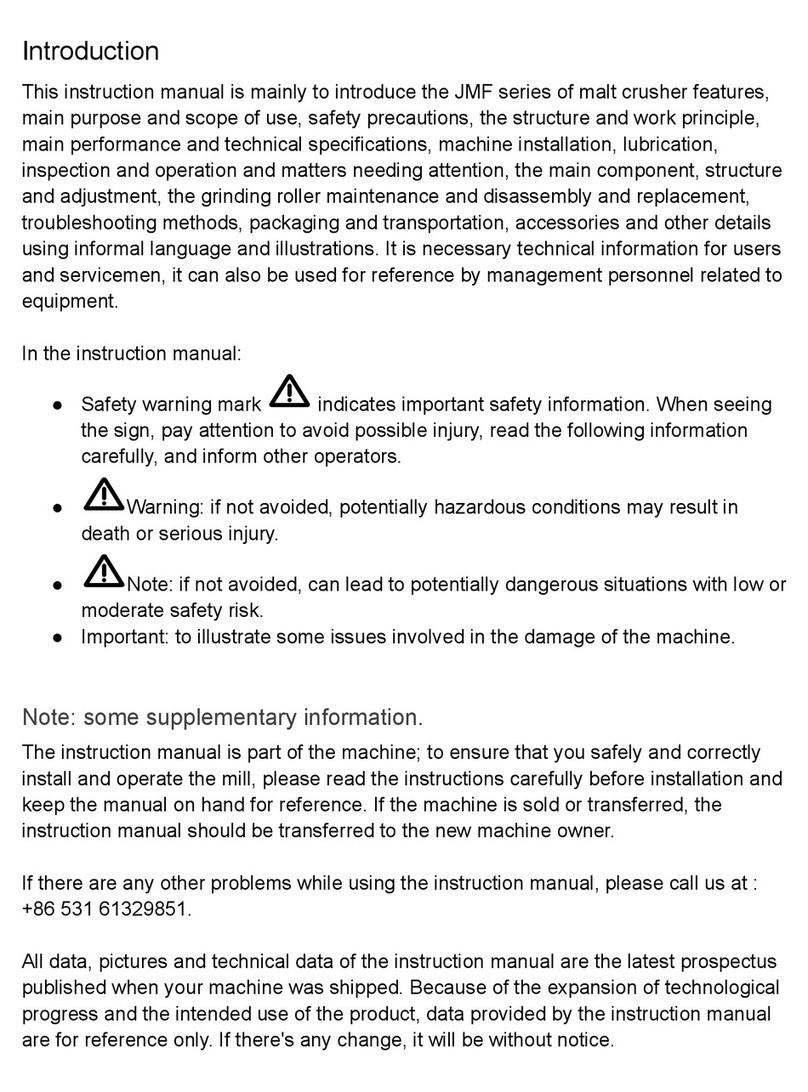
1
MILL MANUAL
MILL91AS-MB MILL95AS-MB
IMPORTANT SAFETY INFORMATION
Please read this entire instruction manual for important
safety information prior to the use of your mill.
Failure to follow these warnings could
result in serious injury or death.
Safety Precautions:
•Follow all safety alert symbols, warnings, safety precautions, and
safety signs, otherwise, injury or machine failure may occur.
•Operating personnel must be trained before operating.
•Before using the mill, the operator must read and understand all
instructions, master the content, and strictly abide by all safety
regulations.
•All safety labels must be kept clean. If labels are damaged or lost,
they must be ordered and re-labeled before use.
•DO NOT make alterations to the mill as it can cause performance
degradation, damage, and become a danger to safely operate.
General Precautions:
Please adhere to the following points when ad-
justing and operating the machine before running the machine,
confirm the motor is grounded safely. Ensure all the parts and
adjustments are fastened securely.
•If you hear any unusual sounds during operation, shut down the
machine and check it immediately.
•During installation and operation, follow all the safety regulations
of the state and local authorities.
•Clean the inside of the machine with a brush or similar product.
DO NOT put your hand into the space between the mill rollers.
Injury or death will occur.
Please adhere to the following points during
the milling process.
•Do not operate the mill with the belt cover removed.
•Do not operate the mill with the transmission cover removed.
Understanding Safety Signs & Symbols:
Three sign words represent the degree of risk: Danger, Warning,
and Attention.
Danger: Means if not avoided, will lead to death or serious injury.
Warning: Means potential danger, if not avoided, will lead to
death or serious injury.
Attention: Means potential danger.
Safety Signs and Post Placement:
•The information conferred by a safety sign refers to personal safe-
ty, which the operator must execute strictly.
•Safety signs must be kept visible, if lost please have them replaced
promptly.
•When changing new parts within the maintenance period, the
safety sign should be changed. Dierent machine types require
a little dierence in the position and content of the safety sign.
Please take the material object as the standard.
Label 1: Disconnect Power and Lock Out Before Servicing
When maintaining the equipment ensure the power is o. Read
manual before servicing.
Label 2: ROTATING PARTS. Do not reach in. Restrain loose cloth-
ing and long hair.
Entanglement Hazard. Do not operate mill with loos closing, long
exposed hair or jewelry.
Label 3: ROTATING PARTS. Do not reach in. Restrain loose cloth-
ing and long hair.
Crush hazard, keep hands clear during operation.
Label 2:
Label 3:
Label 1:


























